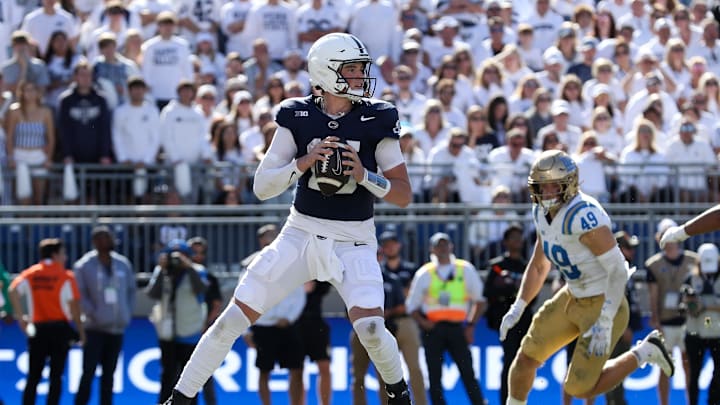How Penn State's Passing Game Has Changed This Season

Before the season, Penn State coach James Franklin and offensive coordinator Andy Kotelnicki emphasized to exhaustion their primary mission: to get the football to their best offensive players. Through five games, Franklin said Penn State largely has accomplished that. So has quarterback Drew Allar, who evolves his passing confidence by stretching his offensive targets.
Through five games, four different Nittany Lions have recorded 100-yard receiving games, the latest by Liam Clifford against UCLA. Clifford set a career-high with 107 yards against the Bruins, a game that that featured three catches, all on third down, with the longest covering 57 yards. Clifford joined teammates Trey Wallace (117 vs. West Virginia), Tyler Warren (146 vs. Bowling Green) and Omari Evans (116 vs. Kent State) in the 100-yard club. This season marks the first since 2017 that at least four Penn State players have recorded 100-yard receiving games.
That spread, and the stress it places on defenses, has lifted Allar to fifth nationally in pass-efficiency rating. As a team, the Nittany Lions rank fourth nationally with Allar and Beau Pribula combining for a 71.1-percent completion rate, which ranks ninth nationally. For Allar, Kotelnicki's system has made a significant difference and it will matter again Saturday, when the No. 4 Nittany Lions visit USC.
RELATED: What if James Franklin had left Penn State for USC?
"It starts with the offensive staff and coach [Kotelnicki] and scheming guys to get open as the primary receiver," Allar said. "That's kind of why we've seen a lot of that this season. ... That's a big part of why there's so much ball distribution. Whoever's open, just give them an accurate football and let them make the play after the catch."
As Allar said, Penn State takes a twin approach to scheming its passing game week-to-week. First, Kotelnicki identifies stress points in an opposing defense that specific players can exploit. Against West Virginia in the opener, Wallace led the team in targets and receptions. Warren was the primary against Bowling Green. Evans got open deep for a big play against Kent State, as did Clifford downfield against UCLA. All four are veterans in Penn State's offense.
"I think we are doing a good job of getting the ball in our playmakers' hands, specifically the guys that have been proven commodities already here at Penn State," Franklin said. "I still think there's some guys, specifically at the wide receiver position, that we have to continue to get the ball in their hands to develop that aspect of our offense. ... We would like it to be a little bit more consistent, but I think it's helpful that when you watch our tape or when you study us, all those guys have made plays at times. And that's concerning, that it's not just one guy that if you stop this guy, you're going to stop the offense."
Last season, Penn State's receivers room largely revolved around KeAndre Lambert-Smith, who caught 42 percent of the position's passes. This year, with Warren leading Penn State with 23 receptions, the receivers are much more blended. The core group of Wallace, Evans, Clifford and Julian Fleming have combined for 39 catches, with Wallace leading at 14.
Allar said called that blend intentional, with Kotelnicki scheming specific receivers against specific coverages. Further, Kotelnicki explains how and why he's doing so.
"Every play that we call in a game has the intention of getting our playmakers the ball in space and getting the [ball to] guys that we want, that have a specific skillset or are really good at getting the ball quick or just taking advantage of their skillset and scheming them open," Allar said. "That's been a huge help for us this year, a huge help for me, just knowing why we’re calling the play, the intention of the play and the situation it’s going to come up in. That’s not only helped me but it’s really helped the whole offense. They understand they why behind everything.
"... We’re very intentional about that every play. We want to have answers built into the play, and if we don’t we get to another play. It's trusting what I see with my eyes and then going through progressions. Every play is built with answers within it."
That will come up again vs. USC, whose pass defense ranks fifth in the Big Ten behind Penn State's. The Trojans are particularly strong on third down, fielding the Big Ten's lowest conversion percentage.
"I think schematically they’re going to be really good they’re going to be really sound in what they’re doing," Allar said of USC's defense. "It’s going to e a real tough challenge with the amount of talent and athleticism they got on that side of the ball."
Kickoff for Saturday's Penn State-USC game is scheduled for 3:30 p.m. ET Saturday at Los Angeles Memorial Coliseum. CBS will televise.
More Penn State Football
What James Franklin said about preparing for the USC Trojans
"Punishing" has been a theme word for Penn State's offense
James Franklin calls Penn State's 5-0 start "impactful." Now the hard part
Penn State on SI is the place for Penn State news, opinion and perspective on the SI.com network. Publisher Mark Wogenrich has covered Penn State for more than 20 years, tracking three coaching staffs, three Big Ten titles and a catalog of great stories. Follow him on X (or Twitter) @MarkWogenrich.
